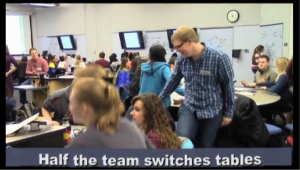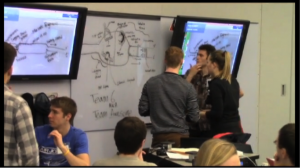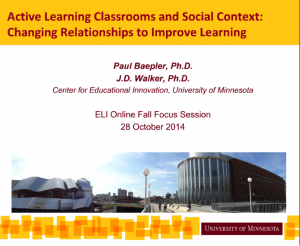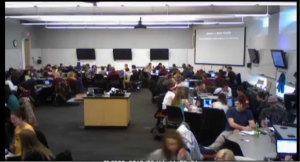This year, EDUCAUSE Learning Initiative organised a two-day web conference about learning spaces: Re-imagining the Learning Space: Design, Technology and Assessment, where Paul Baepler and J. D. Walker, from the Center for Educational Innovation, at the University of Minnesota, presented.
The title of their presentation, “Active Learning Classrooms and Social Context: Changing Relationships to Improve Learning” clearly communicates their pedagogical approach to learning space design, use and assessment. The Center defines ALCs as rooms that aim to “foster interactive, flexible and student-centered experiences”.
You can read more about this here and here, but their focus on active learning, their learner-centred approach and research focus is evident at a glance.

Not only do they follow a learner-centred approach to their room design, they rely on established models to do so: the SCALE-UP model to design the rooms and the curriculum and the PAIR-UP model to assess their impact on teaching and learning and achievement.
SCALE-UP, or Student-Centered Active Learning Environment with Upside-down Pedagogies, is a flipped learning approach, with a heavy emphasis on guided learning, active learning and the social interactions that occur inside the room. PAIR-UP relies heavily on collaboration between all the stakeholders.
The room design is shaped by these pedagogies. Check their website for a brief overview of their curriculum and learning space design and delivery methods.
The Center for Educational Innovation has been evaluating the impact of their active learning classrooms and curriculum design and delivery for a while and publishing their findings: on the impact of learning spaces in teaching, studying, achievement, etc. and on the link between their new learning spaces, curriculum design and delivery, active learning and achievement.
They’ve reached some interesting conclusions:
- faculty teaching in new learning spaces and students learning in them both had strongly positive attitudes toward the spaces at the end of the term;
- both faculty and students perceived reduced psychological distance between faculty and students, and among students;
- the round tables in the ALCs were singled out as especially important to the impact of the rooms on teaching and learning.
- students taking classes in the ALCs exceeded final grade expectations relative to their ACT scores, suggesting strongly that features of the spaces contributed significantly to their learning;
- different learning environments affect teaching-learning activities even when instructors attempt to hold these activities constant;
- in their choices of informal study spaces, students fall into routines early and are reluctant to deviate from them even if they are not meeting their study goals; and
- assignment types greatly impact the study environments that students select.
http://it.umn.edu/services/all/academic-technology-support/research-evaluation/selected-research/learning-environments/index.htm
Not happy with this, they want to find out why these rooms have such a positive impact; their research so far leads to define social context as the mechanism of impact, and they define it as “ (…) the pattern of relationships in a classroom”. From research and experience they’ve identified social context as the main drive for learning.
As they’ve concluded social context matters to learning and is different in ALCs,
their feature research will focus on measuring it and the types of interactions between:
- Student-student
- Student-lecturer
- Student and self-efficacy

Their future research will focus on finding out if and how social context is stronger and better in ALCs and is associated with student outcomes, or, in other words, if and how it has an impact in learning, collaboration, independent learning and achievement.
It’s ambitious work, where space, technology, pedagogy and research are part of a greater whole. The learner-centred approach has lecturers and students actively involved and gives a sound, pedagogical approach to the use of the ALCs; the findings and feedback from research inform the room and learning design. It’s not an assessment technology, or of a new teaching and learning space; it’s research of an ALC in use, with all the complications it brings, all the research challenges, but with the much greater insight (impact on achievement, for instance).
There is, throughout the process, an integrated, cyclical approach to research, learning design and delivery, which shows how pedagogy can and should lead the integration and development of technology and the best use of space, and how teaching can, and is, in fact a design science.




